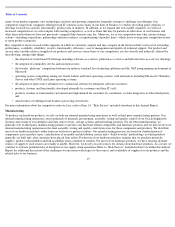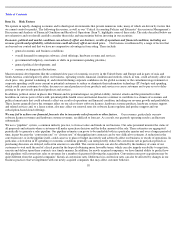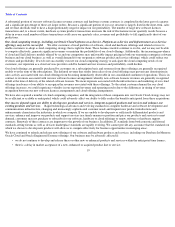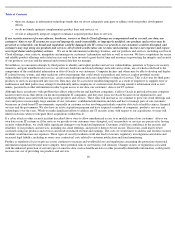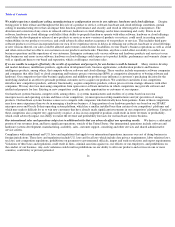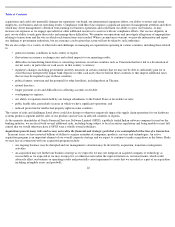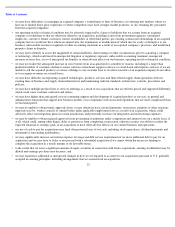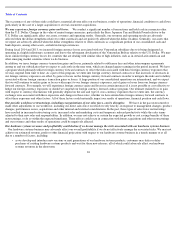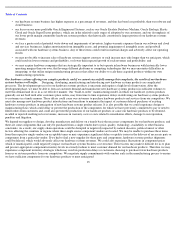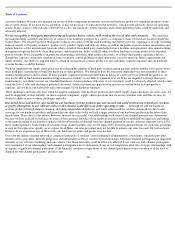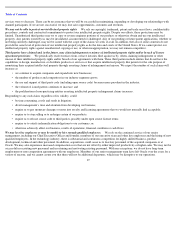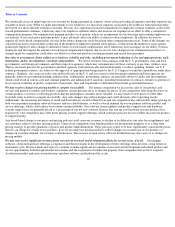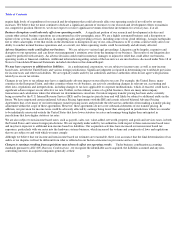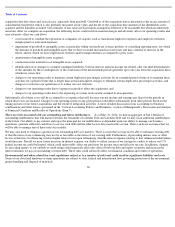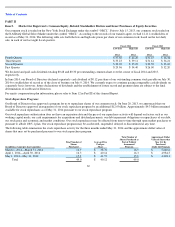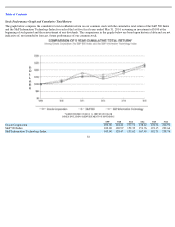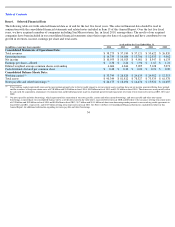Oracle 2013 Annual Report Download - page 29
Download and view the complete annual report
Please find page 29 of the 2013 Oracle annual report below. You can navigate through the pages in the report by either clicking on the pages listed below, or by using the keyword search tool below to find specific information within the annual report.
Table of Contents
Our hardware systems offerings are complex products, and if we cannot successfully manage this complexity, the results of our hardware
systems business will suffer.
Designing, developing, manufacturing and introducing new hardware systems products are complicated
processes. The development process for our hardware systems products is uncertain and requires a high level of innovation. After the
development phase, we must be able to forecast customer demand and manufacture new hardware systems products in sufficient volumes to
meet this demand and do so in a cost effective manner. Our “build-to-order” manufacturing model, in which our hardware systems products
generally are not built until after customers place orders, may from time to time experience delays in delivering our hardware systems products
to customers in a timely manner. These delays could cause our customers to purchase hardware products and services from our competitors. We
must also manage new hardware product introductions and transitions to minimize the impact of customer delayed purchases of existing
hardware systems products in anticipation of new hardware systems product releases. It is also possible that we could experience design or
manufacturing flaws which could delay or prevent the production of the components for which we have previously committed to pay or need to
fulfill orders from customers and could also prevent the production of our hardware products or cause our hardware products to be returned,
recalled or rejected resulting in lost revenues, increases in warranty costs or costs related to remediation efforts, damage to our reputation,
penalties and litigation.
We depend on suppliers to design, develop, manufacture and deliver on a timely basis the necessary components for our hardware products, and
there are some components that can only be purchased from a single vendor due to price, quality, technology, availability or other business
constraints. As a result, our supply chain operations could be disrupted or negatively impacted by natural disasters, political unrest or other
factors affecting the countries or regions where these single source component vendors are located. We may be unable to purchase these items
from the respective single vendors on acceptable terms or may experience significant delays or quality issues in the delivery of necessary parts or
components from a particular vendor. If we had to find a new supplier for these parts and components, hardware systems product shipments
could be delayed, which would adversely affect our hardware systems revenues. We could also experience fluctuations in component prices
which, if unanticipated, could negatively impact our hardware systems business cost structure. These factors may make it difficult for us to plan
and procure appropriate component inventory levels in a timely fashion to meet customer demand for our hardware products. Therefore we may
experience component inventory shortages which may result in production delays or customers choosing to purchase fewer hardware products
from us or systems products from our competitors. We negotiate supply commitments with vendors early in the manufacturing process to ensure
we have sufficient components for our hardware products to meet anticipated
25
•
our hardware systems business has higher expenses as a percentage of revenues, and thus has been less profitable, than our software and
cloud business;
•
our focus on our more profitable Oracle Engineered Systems, such as our Oracle Exadata Database Machine, Oracle Exalogic Elastic
Cloud and Oracle SuperCluster products, which are in the relatively early stages of adoption by our customers, and our de-emphasis of
our lower profit margin commodity hardware systems products that historically constituted a larger portion of our hardware systems
revenues;
•
we face a greater risk of potential write-downs and impairments of inventory, higher warranty expenses than in our software and cloud
and services businesses, higher amortization from intangible assets, and potential impairment of intangible assets and goodwill
associated with our hardware systems business. Any of these items could result in material charges and adversely affect our operating
results;
•
we may not be able to increase sales of hardware systems support contracts or such increase may take longer than we anticipate, which
could result in lower revenues and profitability, or slower than expected growth of such revenues and profitability; and
•
we may acquire hardware companies that are strategically important to us but operate in hardware businesses with historically lower
operating margins than our own; that leverage different platforms or competing technologies that we may encounter difficulties in
integrating; or that utilize unique manufacturing processes that affect our ability to scale these acquired products within our own
manufacturing operations.


